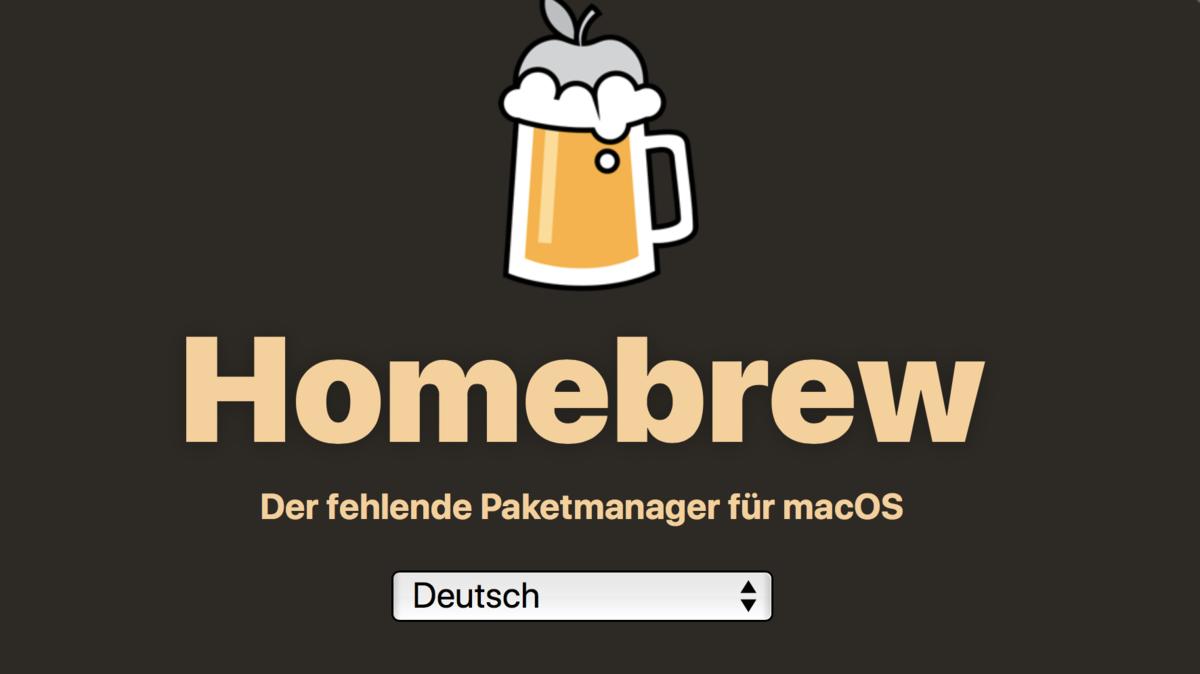Translations of this page:Français (Translators, please see Discussion page.)
Homebrew lets you use commands to download and install Python, Ruby, MongoDB, PHP, Git, Node.js, cask, colordiff, Nmap, and other Unix command-line utilities. In this guide, I’ll show you how to install Homebrew in macOS Catalina or M1 Mac. First check if you have access to the file: If this is the case, note that your directories.
Installing WineHQ packages
Official WineHQ packages of the development and stable branches are available for macOS 10.8 to 10.14 (Wine won't work on macOS Catalina 10.15). Please test these packages and report any bugs at http://bugs.winehq.org.
Prerequisites:
- XQuartz >= 2.7.7
- Gatekeeper must not be set to block unsigned packages.
Installing:
Both .pkg files and tarball archives are available at https://dl.winehq.org/wine-builds/macosx/download.html.
Installing from a .pkg file is recommended for inexperienced users.
To install from a .pkg file, double-click on the package, and the usual macOS installer wizard should open. The process should be self-explanatory. It is possible to install the package either for all users (needs administrator privileges), or just for your current user. After the installation is finished, you should find an entry 'Wine Staging' or 'Wine Devel' in your Launchpad. By clicking on it, a new Terminal window opens with a short introduction into some important wine commands. You can now directly start wine/winecfg/.. from the Terminal, as the PATH variable is set correctly. For user convenience, the package also associates itself with all *.exe files, which means you can run windows executables just by double-clicking on them.
To install from a tarball archive, simply unpack it into any directory. There is no need to set DYLD_* environment variables; all paths are relative, so it should work as long as the directory structure is preserved (you can skip the /usr prefix though using --strip-components 1).
For more information, see https://www.winehq.org/pipermail/wine-devel/2015-December/110990.html and https://www.winehq.org/pipermail/wine-devel/2016-January/111010.html.
Installing Winehq packages using homebrew
Winehq packages can be installed using homebrew
XQuartz can be installed using; Bootcamp update download app.


To install wine the following command can be used;
wine-stable, wine-devel or wine-staging packages can be installed using the above example.The advantage of installing via homebrew means wine is available from a standard terminal sessionThe --no-quarantine line to used to above brew adding the quarantine bit
Building Wine
See Building Wine on macOS
Uninstalling Wine
- Remove the source tree and binaries.
Using Homebrew:
Using MacPorts, uninstall the wine package you previously installed:
Replace wine with wine-devel if you installed the development version.
Otherwise and if you used `sudo make install`, revert it:
Then simply delete your local Wine source code directory:
- Clean-up pseudo C: drive and registry entries as well as all programs installed to C:
- Check the hidden directory `$HOME/.local/` where Wine stores some desktop menu entries and icon files as it interoperates with the X.Org Foundation and the Free Desktop.
Note: Files in this directory are unused on macOS unless you use a UNIX window manager and other X11 applications instead of the native MacOS apps.
Third Party Versions
Third party versions of Wine, such as Wineskin, Winebottler, and PlayOnMac, are not supported by WineHQ. If you are using one of those products, please retest in plain Wine before filing bugs, submitting AppDB test reports, or asking for help on the forum or in IRC.
See Also


| Developer(s) | Jonathan del Strother, currently developed by Apple |
|---|---|
| Operating system | macOS (on iTunes only Mac OS X Tiger on iTunes 7 onwards) (full Cover Flow support Mac OS X Leopard-macOS High Sierra), Windows (iTunes), iOS (iPhone OS 1–iOS 8.3), iPod Nano 3rd Generation, iPod Nano 4th Generation, iPod Nano 5th Generation, iPod Classic 6th Generation |
| Type | Music software |
| License | Proprietary |
| Website | www.steelskies.com |
Cover Flow is an animated, three-dimensional graphical user interface element that was integrated within the Macintosh Finder and other Apple Inc. products for visually flipping through snapshots of documents, website bookmarks, album artwork, or photographs.
Cover Flow is browsed using the on-screen scrollbar, mouse wheel, gestures, or by selecting a file from a list, which flips through the pages to bring the associated image into view. On iPod and iPhone devices, the user slides their finger across the touch screen or uses the click wheel.
Apple discontinued the use of Cover Flow after settling a patent suit against Mirror Worlds. It is now absent on the Mac in everything other than 'Finder' with OS X El Capitan.[citation needed] In macOS Mojave, a completely different Gallery view feature 'replaces' Cover Flow in 'Finder'.[1] It was removed from iOS in 2015 with the release of iOS 8.4, which replaced the Music app with Apple Music.
History[edit]
Cover Flow was conceived by artist Andrew Coulter Enright[2] and originally implemented by an independent Macintosh developer, Jonathan del Strother. Enright later named the interaction style fliptych to distinguish it from the particular Cover Flow implementation.[3]
Cover Flow was purchased by Apple Inc. in 2006,[4] and its technology was integrated into its music application, iTunes 7.0, which was released September 12, 2006.[5] The name was previously 'CoverFlow' without a space.
The last release of Steel Skies’ stand-alone application, version RC1.2, was released on September 10, 2006, and was freely distributed until the end of the next day only, however it remains available for download from MacUpdate.
On January 9, 2007, when Apple announced the iPhone, it was announced that it would incorporate Cover Flow technology.
During the WWDC Keynote on June 11, 2007, Steve Jobs announced that Cover Flow would be added as a view option in Mac OS X Leopard's Finder.
On September 5, 2007 Apple announced that Cover Flow would be utilized in the third generation iPod nano as well as the new iPod classic and iPod touch models. Cover Flow was integrated into the fourth generation iPod nano by the use of an accelerometer which accesses Cover Flow when the iPod nano is turned horizontally on its side.
On March 14, 2008, Mirror Worlds LLC sued Apple for infringing on its patents (nos. 6006227, 6638313, 6725427, and 6768999) (Mirror Worlds, LLC, vs Apple, Inc; Texas Eastern District Court) [6]
On February 24, 2009, Cover Flow was also included with the public beta of Safari 4, with the final version of Safari 4, released on June 8, using Cover Flow to browse history, bookmarks, RSS feeds, Bonjour, and Address Book.
In April 2010, Apple was granted US design patent D613,300 on the Cover Flow interface.[7]
On October 1, 2010, Apple was ordered to pay $625.5 million to Mirror Worlds LLC for infringing utility patents relating to Cover Flow.[8][9] On April 4, 2011, Judge Davis reversed the judgement.[10]
With the release of version 11 of iTunes, Cover Flow was removed from the iTunes interface.
iOS 7 saw Cover Flow replaced by Album Wall.[11] This feature shows tiles of album art in rows when the device is in landscape.[12] This feature was removed with the release of iOS 8.4 on June 30, 2015
Homebrew On Catalina

In macOS Mojave, Cover Flow was removed from Finder and replaced by gallery view.
Other implementations[edit]
Homebrew Catalina Gcc
- The open-source media player Songbird offers a Cover Flow navigation add-on called MediaFlow.[13]
- The open source Banshee media player also offers a Cover Flow-like add-on called ClutterFlow,[14] which is based on the Clutter toolkit.
- The proprietary media player MediaMonkey also offers a Cover Flow add-on called MonkeyFlow.[15] It can either be embedded or run as an external remote application.
- Using Compiz Fusion (Shift Switcher)[16] or KDE Plasma Workspaces (Cover Switch on KWin 4.1 or later)[17] on a Unix-like system, it is possible to switch between open applications with a Cover Flow animation.
- A Cover Flow-like interface was used by the graphical search engine Search Me.
- When selecting music or course in arcade edition of Dance Dance Revolution X2 and later, a Cover Flow-style interface is used.
- The free jukebox firmware Rockbox also implements a Cover Flow-like album art viewer, called 'PictureFlow'. However, PictureFlow is not part of the main UI, instead included as a demo.
- Reflection Music Player also implements a Cover Flow-like Music Player for the iPad Reflection Music Player with Cover Flow on iTunes
- The open source ebook managing software calibre incorporates Cover Flow to browse through ebooks' covers.
- Open source multi-system game emulator OpenEmu includes a cover flow view
- By default, the Nintendo Wiihomebrew application WiiFlow displays games in a Cover Flow-like interface.
References[edit]
- ^'The next version of macOS is macOS Mojave – TechCrunch'. techcrunch.com. Retrieved June 12, 2018.
- ^'Dissatisfaction Sows Innovation'. Archived from the original on March 31, 2005. Retrieved October 9, 2013.
- ^'The Fliptych Interface'.
- ^'CoverFlow'. SteelSkies.com.
- ^'Apple Purchased CoverFlow For iTunes 7'. Archived from the original on May 20, 2008.
- ^http://dockets.justia.com/docket/texas/txedce/6:2008cv00088/108627/
- ^'US Design Patent D613,300'.
- ^'Apple Challenges Big Award Over Patents'. The New York Times. October 4, 2010. Retrieved October 5, 2010.
Apple is challenging a jury verdict that could force it to pay as much as $625.5 million to a company founded by David Gelernter, a Yale computer science professor, for infringing three patents related to how files are displayed on the iPod, the iPhone and Macintosh computers.
- ^Decker, Susan. 'Apple Challenges $625.5 Million Mirror Worlds Patent Verdict'. bloomberg. Retrieved October 4, 2010.
- ^'Judge reverses $625.5 million patent judgement previously awarded to Mirror Worlds'.
- ^Staff (2013). 'iOS 7'. Apple Inc. Retrieved December 29, 2013.
Rotate your iPhone or iPod touch to browse your music with the Album Wall
- ^Klug, Brian; Saumitra Bhagwat (November 19, 2013). 'The iOS 7 Review'. AnandTech. Retrieved December 29, 2013.
The Music app also uses a red and white color scheme and has been completely revamped in iOS 7, making extensive use of transparencies and featuring a new album art wall in landscape mode.
- ^'Songbird MediaFlow Add-on'. Archived from the original on February 2, 2013.
- ^'Banshee ClutterFlow Add-on'.
- ^'MonkeyFlow Add-on'.
- ^Plugins/SwitcherArchived October 30, 2007, at the Wayback Machine (Compiz Fusion Wiki), accessed October 29, 2007.
- ^Cover switch effect on YouTube (Martin Graesslin, video)
